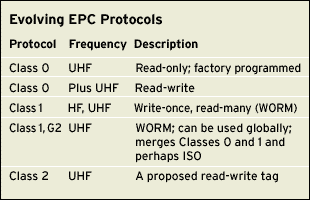The RFID industry has been riven by two different proposed standards. One is being developed by the International Organization for Standardization (ISO), which is supported by established RFID systems providers, particularly those in Europe. The other is the Electronic Product Code system that is being commercialized by EPCglobal, a nonprofit organization set up by EAN International and the Uniform
Code Council. It’s backed mainly by end-user companies, such as Carrefour, Gillette, Procter & Gamble, Tesco and Wal-Mart. If the groups that support these different RFID standards don’t have a meeting of the minds, companies could be forced to use one system or the other—or worse, use both.
ISO has been working on a series of standards governing the air-interface protocol—the way RFID tags and readers communicate—for the past five years. The Auto-ID Center, a nonprofit research and development group based at MIT, was formed in 1999 to create a low-cost system for tracking goods using RFID tags (the center recently closed and its work is being carried on by EPCglobal and Auto-ID Labs). The center chose not to use the ISO protocols, setting up the conflict between the two proposed standards.
Looming conflict
The dispute will come to a head early this year, because the ISO standards for the RFID air-interface protocol are nearing completion. At the same time, EPCglobal has begun work on the second version of its Class 1 protocol. The main goal of supporters of EPC is to merge Class 1 and Class 0, which currently are not interoperable. That would mean that one reader could read all EPC tags. Those in favor of this approach would simply ignore ISO.
But ISO-compliant product vendors and some end users are pushing EPCglobal to make the EPC Class 1, Version 2, protocol the ISO protocol. In other words, EPC tags would carry an EPC number—a unique serial number that identifies an individual pallet, case or item—but communicate with readers using an ISO-approved air-interface protocol. This would essentially force the two companies currently supporting EPC technology, Alien Technology and Matrics, to scrap their current systems and adopt the ISO system. The final option is to make it possible for EPC tags to work with either ISO or EPC protocols.
The benefits of interoperability
Complete interoperability of ISO and EPC protocols would offer end users several important benefits. First, companies using RFID technologies wouldn’t have to worry about using two incompatible systems in different regions of the world. Second, there would be a large number of technology providers capable of building products that can work with each other, which would encourage competition and drive down prices. And last, it would guarantee that companies could buy products from a variety of vendors with complete confidence that they would all work together seamlessly.
But there could be some downsides to interoperability. Generally speaking, making different protocols interoperable adds complexity to the tags and readers, which adds to the cost and could degrade system performance. A protocol that merges three existing protocols (EPC Classes 0 and 1 and ISO) could mean that more data has to be transferred via radio waves between the tag and reader. It’s possible that tags and readers developed for an interoperable system might not perform as well as today’s ISO and EPC products.
A more significant issue is cost. The EPC vision is one of very simple low-cost tags being placed on billions of cases of product. To get the cost as low as possible, the Auto-ID Center chose not to adopt the ISO protocol, which the center felt would require a more complex microchip in the tag. It opted instead to develop its own protocol and put only a serial number on the tag.
Hard choices ahead
If EPCglobal creates a protocol that merges the existing Class 1 and Class 0 EPC protocols and then makes that combined protocol interoperable with the ISO protocol, the microchips could become more complex and therefore larger. A larger chip adds cost to the final price of the tag. Even a tenth of a cent is important when you are talking about selling billions of tags containing these chips. Readers could also wind up costing more.
EPCglobal has a Hardware Action Group (HAG) made up of vendors already working together to deliver the Class 1, Gen2, protocol. HAG is supposed to develop this based on input from EPCglobal’s User Action Group, which is composed of companies that will use EPC technology. The goal is to have RFID tags based on this protocol on the market by the third quarter of 2005. Japan and the European Union are both planning to change their regulations regarding the use of the ultra-high frequency (UHF) band of the radio spectrum (868 to 956 MHz) for RFID systems. The new EPC protocol will enable RFID systems to take advantage of these changes to provide better performance.
EPCglobal is encouraging end users—particularly large, early adopters such as Wal-Mart and the U.S. Department of Defense—to participate in committees that will guide the process of developing the Class 1, Gen2, protocol. The key questions end users must grapple with are: How important is it to have a formal international standard (as opposed to a de facto standard)? How much do they value interoperability between EPC and ISO products? And what trade-offs—if trade-offs are needed—are they willing to make to get it?
EPCglobal could consider other options. One would be to allow EPC tags to communicate using either the existing Class 1, Class 0 or ISO protocol, which would force end users to buy multiprotocol readers. Or EPCglobal could work with ISO to create an entirely new protocol that borrows the best features of each existing protocol. But that system would probably not be backward-compatible with current RFID technology.
If EPC Class 1, Gen2, sacrifices too much in performance for the sake of interoperability or makes tags and readers more expensive, end users might refuse to adopt the new protocol. That means that those who invest in either ISO or EPC technology today will be forced to continue to use the same protocol, which could create a split over technology standards. That would be a disaster for end users that want one system to track goods through the global supply chain.



